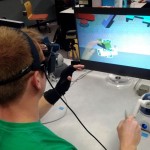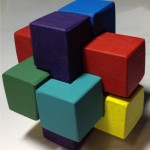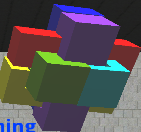Iowa State University
Overview
Our research aims to improve the training of assembly tasks through the utilization of haptic devices, virtual reality, and accurate physics calculations.
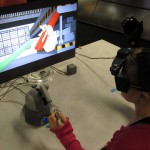
A user assembling virtual pieces using a Phantom Omni and 5DT Data Glove
The wooden physical burr puzzle (left), colored physical burr puzzle (middle), and virtual burr puzzle (right).
In training assembly workers in a factory, there are often barriers such as cost. Assembly lines need to be shutdown which can cause serious disruption for the factory. Virtual reality and haptic technology can be used to provide simulated training for situations in which physical training is either too costly or dangerous due to the size of the assemblies. This research compared virtual bimanual haptic training versus traditional physical training and the effectiveness for learning transfer for a puzzle assembly.
In our first study, a small group of participants went through either virtual training or physical training for a puzzle assembly. During a training phase, participants received a paper copy of instructions for puzzle assembly and then went through assembling the color coded puzzle twice using either the physical puzzle for training or the virtual setup. After this, the instructions were taken away and participants were asked to assemble the physical puzzle without color indicators in the testing phase. Time on task was measured to determine how fast they were able to complete the testing. While virtual training took participants about three times longer, the group that used the virtual environment was able to assemble the physical puzzle testing about three times faster than the group trained with the physical puzzle.
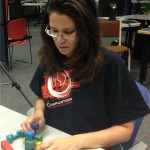
A user assembling the physical burr puzzle.
One issue with the above study was the time that participants had between physical and virtual training depended on how fast they were able to complete the two assemblies. The increased amount of time with the puzzle for the virtual group could be why their performance was better. To control for this, another experiment was devised and implemented. In a between groups design, participants were assigned to either the virtual or physical training and trained by assembling the puzzle as many times as possible for twenty minutes. After training, participants were tested using the physical puzzle and were retested again after two weeks. The coloring of the pieces during testing was also varied. Spatial ability as measured using a mental rotation test, was shown to correlate with the number of assemblies they were able to complete in the training. While physically training significantly outperformed virtual training for the initial test, there were no significant differences in the post test. However, physically trained participants performed worse in the post test while the virtually trained participants performed better. This learning retention for those who were virtually trained is encouraging and is a potential future research area.
Media
- GOALI Study Overview Video (YouTube, Direct Download XVID, 41.5 MB)
Publications
Posters
- Peters, Anicia and Carlson, Patrick and Gilbert, Stephen B. and Vance, Judy M. (2012). A Hybrid Method to Support Natural Interaction of Parts in a Virtual Environment Emerging Technologies Conference, Ames, IA, April 19-20, 2012 (Winner most interesting research project)
- Gilbert, Stephen B. and Vance, Judy M. and Peters, Anicia and Carlson, Patrick. (2012). GOALI: A Hybrid Method to Support Natural Interaction of Parts in a Virtual Environment. NSF Engineering Research and Innovation Conference from the Division of Civil, Mechanical and Manufacturing Innovation (CMMI), Boston, MA, July 9-12, 2012
Conference Proceedings
- Vance, Judy M. and Gilbert, Stephen B. and Oren, Mike and Pavlik, Ryan and Carlson, Patrick. (2011). “GOALI: A Hybrid Method to Support Natural Interaction of Parts in a Virtual Environment”, 2011 NSF Engineering Research and Innovation Conference Proceedings, Atlanta, GA, Jan 4-7, 2011
- Oren, Mike and Carlson, Patrick and Gilbert, Stephen B. and Vance, Judy M. (2012). “Puzzle assembly training: Real world vs. virtual environment”, IEEE Virtual Reality, March 4-8, 2012 Orange County, CA, DOI: 10.1109/VR.2012.6180873.
Funding
- National Science Foundation – Grant Number: CMMI-0928774
